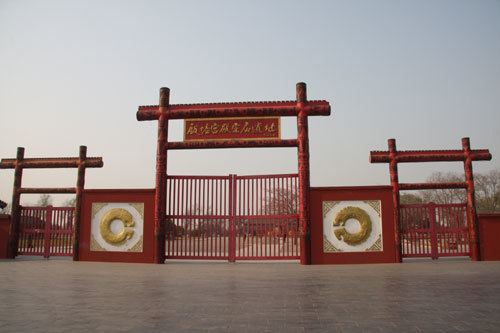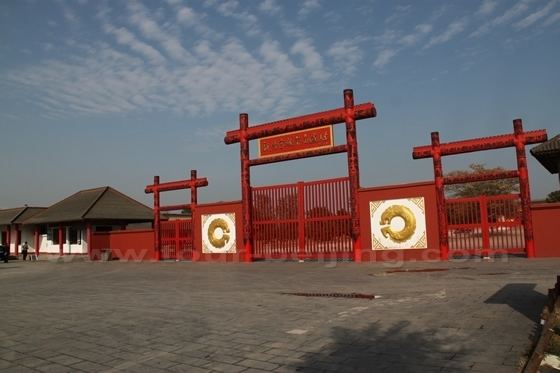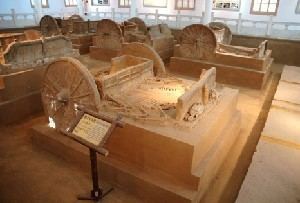Type Cultural Reference no. 1114 Local time Sunday 12:11 PM | Official name Yin Xu Criteria ii, iii, iv, vi State Party China | |
 | ||
Weather 13°C, Wind N at 14 km/h, 31% Humidity | ||
Yinxu the first capital in history of china 1300 bc 1046 bc
Yinxu ( [ín.ɕý]; Chinese: 殷墟; literally: "Ruins of Yin") is the site of one of the ancient and major historical capitals of China. It is the source of the archeological discovery of oracle bones and oracle bone script, which resulted in the recognition of the earliest known Chinese writing. The archeological remnants (or ruins) known as Yinxu represent the ancient city of Yin, the last capital of China's Shang dynasty which existed through eight generations for 255 years, and through the reign of 12 kings. Yinxu was discovered, or rediscovered, in 1899; it is one of China's oldest and largest archeological sites, and is an UNESCO World Heritage Site. Yinxu is located in northernmost Henan province near the modern city of Anyang, and near the Hebei and Shanxi province borders. Public access to the site is permitted.
Contents
- Yinxu the first capital in history of china 1300 bc 1046 bc
- Traditional history
- Archaeological discoveries
- Excavation sites
- Genetic studies
- References

Traditional history

In the Book of Documents, the "Pan Geng" chapter (which is believed to date from the late Spring and Autumn period), describes King Pan Geng moving the capital of the Shang dynasty. According to the Historical Records of Sima Qian, Pan Geng moved his capital from the north of the Yellow River to Bo 亳, the capital of the Shang founder Tang, on the south side of the river. According to the Bamboo Annals, he moved the capital from Yān (present day Qufu, in present-day Shandong Province), to a site called Běimĕng (北蒙) and Yīn (殷). The name "Yin" is an ancient term referring to "vibrant music-making".

From that point on the dynasty would also be known as the Yin dynasty. King Wu Ding continued to use Yin as his capital and launched numerous military campaigns from this base against surrounding tribes thus securing Shang rule and raising the dynasty to its historical zenith.

According to the thraditional accounts, later rulers became pleasure-seekers who took no interest in state affairs. King Zhòu, the last of the Shang dynasty kings, is particularly remembered for his ruthlessness and debauchery. His increasingly autocratic laws alienated the nobility until King Wu of the Zhou dynasty was able to gain the support to rise up and overthrow the Shang.

The Zhou dynasty established their capital at Fenghao near modern-day Xi'an and Yin was abandoned to fall into ruin. These ruins were mentioned by Sima Qian, in his Records of the Grand Historian and described in some detail by Li Daoyuan in his Commentary to the River Classic published during the Southern and Northern Dynasties period (420-589 CE). Thereafter the once-great city of Yin was relegated to legend along with its founding dynasty until the final years of the Qing dynasty.
Archaeological discoveries

Yinxu is famous for its oracle bones, which were first discovered in 1899 by Wang Yirong, director of the Imperial College. Director Wang was suffering from malaria at the time and was prescribed Longgu 龍骨 (dragon bones) at a traditional Chinese pharmacy. He noticed strange carvings on these bones and concluded that these could be samples of China’s earliest writing. He sent his assistant in search of the source of these bones and they were finally traced to the small village of Xiaotun just outside Anyang. In 1917, Wang Guowei deciphered the oracle bone inscriptions of the names of the Shang kings and constructed a complete Shang genealogy. This closely matched that in the Records of the Grand Historian by Sima Qian confirming the historical authenticity of the legendary Shang dynasty and the archaeological importance of Yinxu. However, the oracle bone inscriptions record the name of the state as Dàyìshāng (大邑商) or Shāngyì (商邑).

The first excavations at Yinxu were led by the archeologist Li Ji of the Institute of History and Philosophy from 1928-37. They uncovered the remains of a royal palace, several royal tombs, and more than 100,000 oracle bones that show the Shang had a well-structured script with a complete system of written signs. Since 1950 ongoing excavations by the Institute of Archaeology, Chinese Academy of Social Sciences have uncovered evidence of stratification at the Hougang site, remains of palaces and temples, royal cemeteries, oracle bone inscriptions, bronze and bone workshops and the discovery of the Huanbei site on the north bank of the Huan River. One of the largest and oldest sites of Chinese archaeology, excavations here have laid the foundation for work across the country.

Four periods are recognized at the site. They correlate approximately with oracle bone periods assigned by Dong Zuobin, royal reigns and dates assigned by the Xia–Shang–Zhou Chronology Project as follows:
Excavation sites
At 30 km² this is the largest archaeological site in China and excavations have uncovered over 80 rammed-earth foundation sites including palaces, shrines, tombs and workshops. From these remains archaeologists have been able to confirm that this was the spiritual and cultural center of the Shang dynasty.
The best preserved of the Shang dynasty royal tombs unearthed at Yinxu is the Tomb of Fu Hao. The extraordinary Lady Hao was a military leader and the wife of Shang King Wu Ding. The tomb was discovered in 1976 and has been dated to BCE 1250. It was completely undisturbed, having escaped the looting that had damaged the other tombs on the site, and in addition to the remains of the Queen the tomb was discovered to contain 6 dog skeletons, 16 human slave skeletons, and numerous grave goods of huge archaeological value. The tomb was thoroughly excavated and extensively restored and is now open to the public.
Also located on site is the Exhibition Hall of Chariot Pits where the earliest samples of animal-driven carts discovered by Chinese archaeology are on display. These artifacts were excavated by the Anyang Working Station of the Archaeological Institute of the Chinese Social Science Academy and the Historical Relics Working Team of Anyang Municipality in the northern and southern lands of Liujiazhuang village and the eastern land of Xiaomintun village and put on display within the hall. The six pits each contain the remains of a carriage and two horses. Five of the pits were also found to contain the remains of a human sacrifice (four adult males and one child). Also on display are the remains of an 8.35 meter wide Shang dynasty road discovered at Anyang Aero Sports School in 2000.
In 2006 the site was inscribed on the UNESCO list of World Heritage Sites.
Genetic studies
A study of mitochondrial DNA (inherited in the maternal line) from Yinxu graves showed similarity with modern northern Han Chinese, but significant differences from southern Han Chinese.
